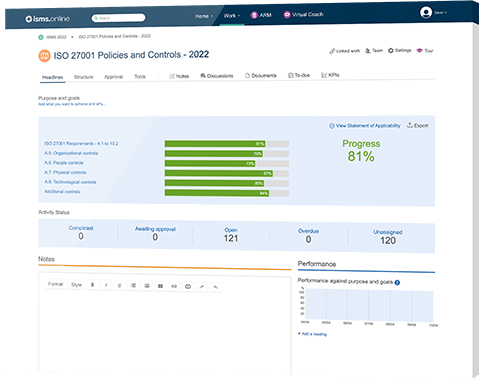
Failure to properly segregate development, test, and production environments may result in loss of availability, confidentiality, and integrity of information assets.
For example, Uber accidentally published a code repository on Github that contained passwords of users from the production environment, resulting in the loss of confidentiality of sensitive information.
Therefore, organisations should implement appropriate procedures and controls to securely segregate development, test, and production environments to eliminate security risks.
Control 8.31 enables organisations to maintain the confidentiality, integrity, and availability of sensitive information assets by segregating developing, testing, and production environments through appropriate procedures, controls, and policies.
Control 8.31 is preventive in nature and it requires organisations to preemptively establish and apply processes and technical controls to securely separate the development, testing, and production environments.
| Control Type | Information Security Properties | Cybersecurity Concepts | Operational Capabilities | Security Domains |
|---|---|---|---|---|
| #Preventive | #Confidentiality #Integrity #Availability | #Protect | #Application Security #System and Network Security | #Protection |
Considering that Control 8.31 entails the establishment and implementation of organisation-wide processes and controls to segregate different software environments, chief information security officer, with help of the development team, shall be ultimately responsible for compliance.
Organisations should take into account the potential production problems that should be prevented when determining the required level of separation between the three environments.
In particular, Control 8.31 recommends organisations consider the following seven criteria:
Organisations should protect development and testing environments against security risks taking into account the following:
Furthermore, no single individual should be given the privilege to make changes in both development and production environments without obtaining approval first. To prevent this, organisations can segregate access rights or establish and implement access controls.
In addition, organisations can also consider extra technical controls such as logging of all access activities and real-time monitoring of all access to these environments.

We’ll give you an 81% headstart
from the moment you log in
Book your demo
If organisations fail to implement necessary measures, their information systems can face significant security risks.
For instance, developers and testers with access to the production environment may make unwanted changes to files or system environments, execute unauthorised code, or accidentally disclose sensitive information.
Therefore, organisations need a stable environment to perform robust testing on the code and to prevent developers from accessing the production environments where sensitive real-world data is hosted and processed.
Organisations should also apply measures such as designated roles together with separation of duty requirements.
Another threat to the confidentiality of production data is the development and testing personnel. When the development and testing teams perform their activities using the same computing devices, they may accidentally make changes to sensitive information or software programs.
Organisations are advised to establish supporting processes for the use of the production data in testing and development systems in compliance with Control 8.33.
Moreover, organisations should take into account the measures addressed in this Control when they perform end-user training in training environments.
Last but not the least, organisations may deliberately blur the lines between development, testing, and production environments. For instance, testing can be performed in a development environment or product testing can be carried out by actual use of the product by staff in the organisation.
27002:2022/8.31 replaces 27002:2013/(12.1.4 and 14.2.6)
While the two versions are similar to a great extent, there are two differences that should be highlighted.
Control 14.2.6 in the 2013 version addresses secure development environments and lists 10 recommendations that organisations should take into account when building a development environment.
The 2022 version, in contrast, did not contain some of these recommendations such as back-up at an off-site location and restrictions on the transfer of data.
In contrast to the 2013 version, Control 8.31 in the 2022 Version provides guidance on how product testing should be carried out and on the use of production data in accordance with Control 8.33.
The ISMS.Online platform helps with all aspects of implementing ISO 27002, from managing risk assessment activities through to developing policies, procedures and guidelines for complying with the standard’s requirements.
It provides a way to document your findings and communicate them with your team members online. ISMS.Online also allows you to create and save checklists for all of the tasks involved in implementing ISO 27002, so that you can easily track the progress of your organisation’s security program.
With its automated toolset, ISMS.Online makes it easy for organisations to demonstrate compliance with the ISO 27002 standard.
Contact us today to schedule a demo.
| ISO/IEC 27002:2022 Control Identifier | ISO/IEC 27002:2013 Control Identifier | Control Name |
|---|---|---|
| 5.7 | New | Threat intelligence |
| 5.23 | New | Information security for use of cloud services |
| 5.30 | New | ICT readiness for business continuity |
| 7.4 | New | Physical security monitoring |
| 8.9 | New | Configuration management |
| 8.10 | New | Information deletion |
| 8.11 | New | Data masking |
| 8.12 | New | Data leakage prevention |
| 8.16 | New | Monitoring activities |
| 8.23 | New | Web filtering |
| 8.28 | New | Secure coding |
| ISO/IEC 27002:2022 Control Identifier | ISO/IEC 27002:2013 Control Identifier | Control Name |
|---|---|---|
| 6.1 | 07.1.1 | Screening |
| 6.2 | 07.1.2 | Terms and conditions of employment |
| 6.3 | 07.2.2 | Information security awareness, education and training |
| 6.4 | 07.2.3 | Disciplinary process |
| 6.5 | 07.3.1 | Responsibilities after termination or change of employment |
| 6.6 | 13.2.4 | Confidentiality or non-disclosure agreements |
| 6.7 | 06.2.2 | Remote working |
| 6.8 | 16.1.2, 16.1.3 | Information security event reporting |
| ISO/IEC 27002:2022 Control Identifier | ISO/IEC 27002:2013 Control Identifier | Control Name |
|---|---|---|
| 7.1 | 11.1.1 | Physical security perimeters |
| 7.2 | 11.1.2, 11.1.6 | Physical entry |
| 7.3 | 11.1.3 | Securing offices, rooms and facilities |
| 7.4 | New | Physical security monitoring |
| 7.5 | 11.1.4 | Protecting against physical and environmental threats |
| 7.6 | 11.1.5 | Working in secure areas |
| 7.7 | 11.2.9 | Clear desk and clear screen |
| 7.8 | 11.2.1 | Equipment siting and protection |
| 7.9 | 11.2.6 | Security of assets off-premises |
| 7.10 | 08.3.1, 08.3.2, 08.3.3, 11.2.5 | Storage media |
| 7.11 | 11.2.2 | Supporting utilities |
| 7.12 | 11.2.3 | Cabling security |
| 7.13 | 11.2.4 | Equipment maintenance |
| 7.14 | 11.2.7 | Secure disposal or re-use of equipment |